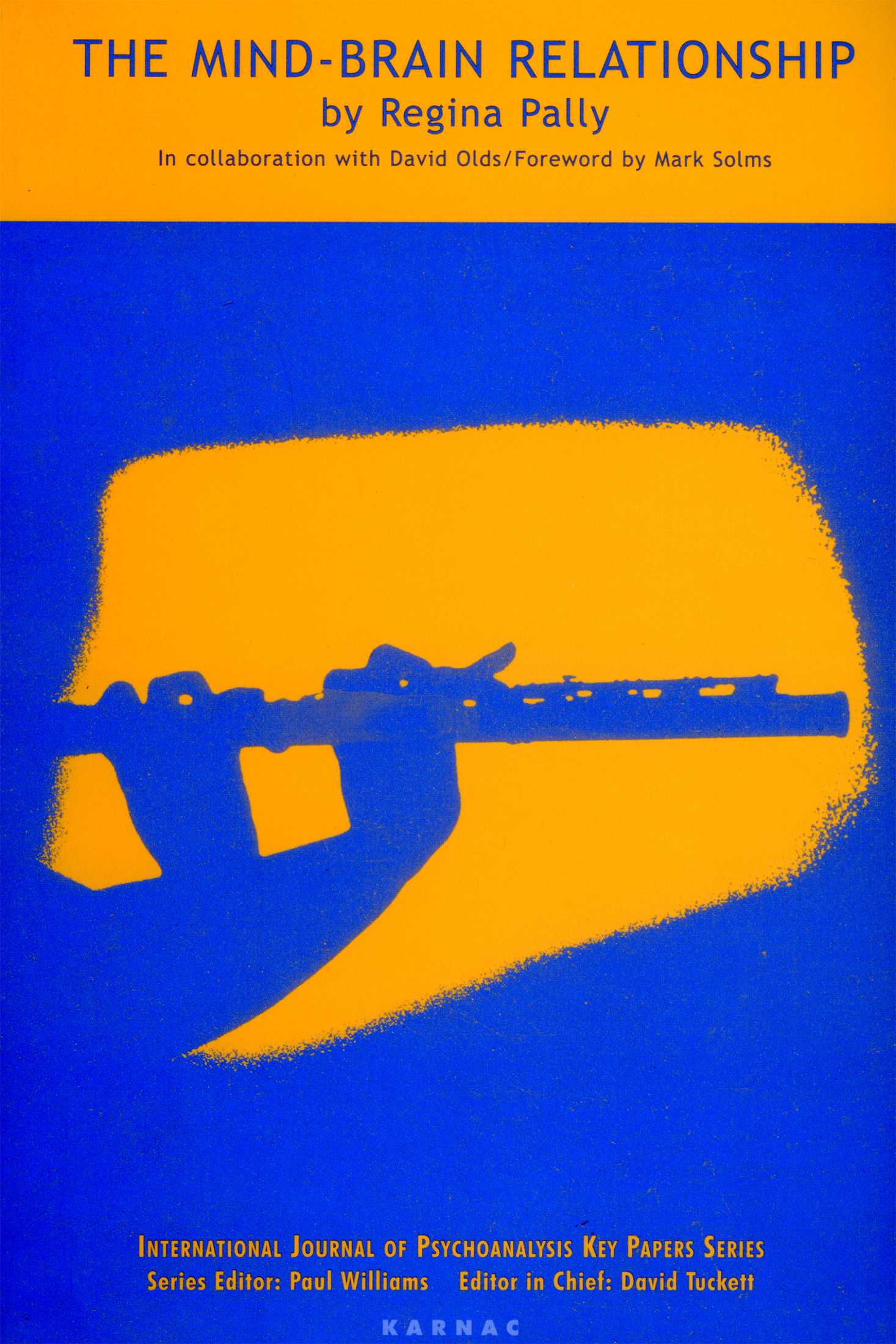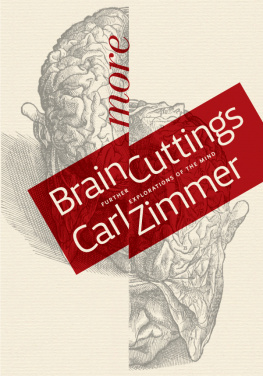Regina Pally - The Mind-Brain Relationship
Here you can read online Regina Pally - The Mind-Brain Relationship full text of the book (entire story) in english for free. Download pdf and epub, get meaning, cover and reviews about this ebook. year: 2020, publisher: Other Press, genre: Romance novel. Description of the work, (preface) as well as reviews are available. Best literature library LitArk.com created for fans of good reading and offers a wide selection of genres:
Romance novel
Science fiction
Adventure
Detective
Science
History
Home and family
Prose
Art
Politics
Computer
Non-fiction
Religion
Business
Children
Humor
Choose a favorite category and find really read worthwhile books. Enjoy immersion in the world of imagination, feel the emotions of the characters or learn something new for yourself, make an fascinating discovery.
- Book:The Mind-Brain Relationship
- Author:
- Publisher:Other Press
- Genre:
- Year:2020
- Rating:3 / 5
- Favourites:Add to favourites
- Your mark:
- 60
- 1
- 2
- 3
- 4
- 5
The Mind-Brain Relationship: summary, description and annotation
We offer to read an annotation, description, summary or preface (depends on what the author of the book "The Mind-Brain Relationship" wrote himself). If you haven't found the necessary information about the book — write in the comments, we will try to find it.
The Mind-Brain Relationship — read online for free the complete book (whole text) full work
Below is the text of the book, divided by pages. System saving the place of the last page read, allows you to conveniently read the book "The Mind-Brain Relationship" online for free, without having to search again every time where you left off. Put a bookmark, and you can go to the page where you finished reading at any time.
Font size:
Interval:
Bookmark:


First published in 2000 by
H. Karnac (Books) Ltd., 58 Gloucester Road, London SW7 4QY
A subsidiary of Other Press LLC, New York
Arrangement, Introduction copyright 2000 Institute of Psychoanalysis; chapters 16 copyright 2000 Institute of Psychoanalysis, republished by permission of the International Journal of Psychoanalysis.
The rights of Regina Pally, David Olds and Mark Solms to be identified as the authors of this work have been asserted in accordance with 77 and 78 of the Copyright Design and Patents Act 1988.
All rights reserved. No part of this publication may be reproduced, stored in a retrieval system, or transmitted, by any form or by any means, electronic, mechanical, photocopying, recording, or otherwise, without the prior written permission of the publisher
British Library Cataloging in Publication Data.
A C.I.P. for this book is available from the British Library.
ISBN9781892746689
Ebook ISBN9781635421231
Edited, designed and produced by Sophie Leighton for the International Journal of Psychoanalysis, cover design by Terry Berkowitz.
www.karnacbooks.com
a_prh_5.6.0_c0_r0
THE INTERNATIONAL JOURNAL OF PSYCHOANALYSIS KEY PAPERS SERIES
This series brings together the most important psychoanalytic papers in the Journals eighty-year history, in a series of accessible monographs, of which this is the first. The idea behind the series is to approach the IJPs intellectual resource from a variety of perspectives in order to highlight important domains of psychoanalytic enquiry. It is hoped that these volumes will be of interest to psychoanalysts, students of the discipline and, in particular, to those who work and write from an interdisciplinary standpoint. The ways in which the papers in the monographs are grouped will vary: for example, a number of themed monographs will take as their subject important psychoanalytic topics, while others will stress interdisciplinary links (between neuroscience, anthropology, philosophy etc. and psychoanalysis). Still others will contain review essays on, for example, film and psychoanalysis, art and psychoanalysis and the worldwide IJP Internet Discussion Group, which debates important papers before they appear in the printed journal (cf www.ijpa.org). The aim of all the monographs is to provide the reader with a substantive contribution of the highest quality that reflects the principal concerns of contemporary psychoanalysts and those with whom they are in dialogue. We hope you will find the monographs rewarding and pleasurable to read.
Paul Williams,
London, 2000.
This accessible review by Regina Pally of aspects of the neuroscience literature relevant to psychoanalysts performs an immensely valuable service. The explosion of knowledge in this area over the past few decades makes it almost impossible for the uninitiated psychoanalytic reader to find his or her bearings in it. And yet find their bearings they must, for there is little doubt that the scientific study and treatment of mental disorders (indeed our understanding of the human mind in general) in the twenty-first century will proceed from the fundamental insights that recent neuroscience has generated. Psychoanalysts who fail to assimilate the new knowledge will be increasingly marginalised both scientifically and professionally, and will be unable to participate in this important intellectual revolution.
The first chapter of this book describes how neural circuitry develops epigenetically, in a manner that directly reflects early environmental influences. These experience-dependent circuits might literally be described as the fabric of the ego. The second chapter reviews perceptual mechanisms, emphasising top-down influences (i.e. the impact of memory, motivation, emotion and attentional factors on current perceptual processing). Pallys review of these mechanisms seems to provide a basis for new insights into a host of clinical phenomena (e.g. transference, projection, hallucination) that have played an important part in the development of psychoanalytic models of the mind. The third chapter discusses the structure and function of memory. Few topics are of more importance for psychoanalytic practice than an understanding of the varieties and vagaries of human memory. The contemporary models surveyed by Pally demonstrate the ongoing fertility of Freuds conception of the dynamic properties and constructed quality of memory. The fourth chapter concerns emotion. Pally correctly emphasises the embodied basis of emotional processing, and draws attention to the unconscious basis and deep evolutionary roots of our emotions, conceptualised by Freud as reproductions of very early, perhaps even pre-individual, experiences of vital importance (1926, Inhibitions, Symptoms and Anxiety, S.E. 20, p. 133). The fifth chapter deals with the perennially fascinating topic of hemispheric asymmetry. Pally provides an introductory overview of right/left differences and describes some of the striking phenomena revealed by split-brain studies. She also offers some speculations on the possible implications for psychoanalysis of the bicameral organisation of the forebrain. The sixth and final chapter addresses the fashionable topic of consciousness, the final frontier of neuroscience. This last chapter provides a systematic and comprehensive overview of the state of the art in the field. Here we see how deeply engaged contemporary neuroscience isno less than psychoanalytic metapsychologywith its philosophical underpinnings.
This book makes it possible for the non-specialist reader to graspalmost in a single sittingthe main thrust of contemporary brain research on a range of topics of vital interest to psychoanalysis. Readers are bound to want to learn more about one or another of these topics, and in this way, they will be effortlessly inducted into this exciting new era of exploration and discovery in mental science.
Mark Solms,
London, 2000
This collection of articles appeared as a series in the International Journal of Psychoanalysis. My purpose in writing these is to provide psychoanalysts and psychotherapists with the basic, fundamental scientific concepts of neurobiology that are relevant to clinical work with patients. In each article, whenever possible, I try to point out the clinical implications of the scientific data.
I am a psychiatrist and my practice consists mainly of long-term psychotherapy and psychoanalysis. I began reading about neuroscience in 1995, simply for interest, unrelated to my clinical work. However, it soon became clear that neuroscience has a lot to offer clinical work and I have been studying, teaching and writing about it ever since.
These articles contain a lot of neuroanatomy, physiology and experimental data, and for those unfamiliar with science this may be somewhat daunting. To avoid being overwhelmed, I want to encourage the reader not to get lost in the facts. The usefulness of neuroscience rests not in specific facts but in the main principles they illustrate. As a guide to what the important principles are, I include here a list of a few examples of neuroscience concepts that address important questions psychotherapists and psychoanalysts face regularly in their work: (1) how the past influences the present; (2) why we need to
Font size:
Interval:
Bookmark:
Similar books «The Mind-Brain Relationship»
Look at similar books to The Mind-Brain Relationship. We have selected literature similar in name and meaning in the hope of providing readers with more options to find new, interesting, not yet read works.
Discussion, reviews of the book The Mind-Brain Relationship and just readers' own opinions. Leave your comments, write what you think about the work, its meaning or the main characters. Specify what exactly you liked and what you didn't like, and why you think so.












